by Tony Dear
Golf in the Pacific Northwest has a rich history, full of characters, frontrunners, visionaries, boom-and-bust epics, and too-good-to-be-true (but mostly they really are true) tales.
This is the sixth in a series of articles, highlighting the people who have made this far corner of the continent our center of the golf universe, and have shaped the way we play the game.
We’ve been touching on just a handful of people, in no particular order, in six categories over several issues of this magazine – the Visionaries, Storytellers, Teachers, Architects, Coaches, and now the Players.
Lists are dangerous things. They are inevitably incomplete, subjective, and all-too-short. So here we go……
(This article first appeared in the November 2019 issue of Pacific Northwest Golfer magazine)
It has been a common theme throughout this series. Be it promoters, storytellers, architects, teachers, coaches, or players, six or seven candidates hasn’t been enough to tell the whole story.
In this Players category, the first handful emerged quickly, but it soon became clear that by choosing them we would be leaving out preeminent golfers such as Pat Lesser Harbottle and Don Bies. There’d be no place for Rick Acton or the Putnam brothers, Michael and Andrew. Or Al Mengert, Ken Still, Ben Crane, and John Fought. No Dave Barr, Dawn Coe-Jones, or Richard Zokol. And what about Sandra Palmer and Ruth Jessen.
Also being omitted would be USGA and Golf Canada national champions, state and provincial greats, PGA and LPGA tour winners, Ryder and Walker Cup players, and even a women’s major champion.
Fred Couples
Born in Seattle 60 years ago, Couples was inducted into the World Golf Hall of Fame in 2013, and that, really, is all you need to explain why the man affectionately known as “Boom Boom” is included here.
But how did the languid, astonishingly powerful swinger from Beacon Hill get there?
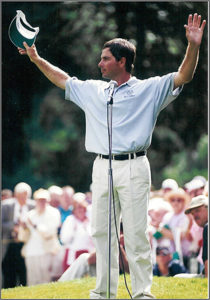
The list of notable achievements extends beyond two pages but, in a nutshell, Couples has won 15 PGA Tour events, including the 1984 and ‘96 Players Championships and 1992 Masters.
Since joining the senior ranks, Couples has won two more majors – the 2011 Senior Players Championship, and 2012 Senior British Open – and 11 other tournaments. With 34 more notable wins, including the 1978 Washington Open where he played as an amateur beating PGA Tour player Don Bies in a playoff, and the 1988 and 1990 Northwest Opens, Couples has accumulated a total of 64 professional victories during a long and captivating career that surely would have yielded many more triumphant moments were it not for back problems that hampered him from 1994 on.
Beyond the PGA and Champions tour success, the highlights just keep piling up – four straight World Cup victories alongside Davis Love III, 26 top-10 finishes in the major championships, five Ryder Cup appearances, seven Presidents Cup appearances (four as a player and three more as a captain), twice being named the PGA Tour’s Player of the Year (1991, 1992), and in 1992 he spent 16 weeks as the world’s No. 1-ranked player, becoming the first American to hold that spot.
JoAnne Carner
JoAnne Carner was JoAnne Gunderson, or “The Great Gundy,” until she married Don Carner in 1963 at the age of 24. By then, she had already won the U.S. Girls’ Junior Championship and the NCAA individual title whilst at Arizona State University.
She had played on four U.S. Curtis Cup teams, and also won the PNGA Women’s Amateur Championship in 1956 and ’58, and also the PNGA Junior Girls’ Amateur in 1956. From 1957 to ’68, she won the U.S. Women’s Amateur title five times, and remained an amateur until the age of 30. Carner won the first of her 43 LPGA Tour titles in 1969, while still an amateur.
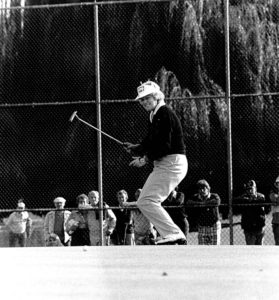
Carner turned professional in 1970, and in 1971 she won her first U.S. Women’s Open, becoming the first (and still only) woman to win the U.S. Girls’ Junior, U.S. Women’s Amateur, and U.S. Women’s Open. She would win a second U.S. Women’s Open five years later, overcoming Sandra Palmer in an 18-hole playoff at Rolling Hill GC in Springfield, Pa.
In all, “Big Mama” – the second pseudonym she came to be known by – amassed 32 top-10 finishes in the LPGA majors, and was the second woman to pass the $1 million mark in career earnings. She would continue playing competitively well into her 60s, and is the oldest player to make a cut on the LPGA Tour, doing so at age 65.
The 1981 Bob Jones Award recipient for sportsmanship, and 1994 U.S. Solheim Cup team captain, Carner was inducted into the World Golf Hall of Fame in 1982 and the PNGA Hall of Fame in 1999.
Peter Jacobsen
A native of Portland, “Jake” graduated from the University of Oregon where he was a three-time All-American.
He won the Oregon Open as an amateur in 1976, and turned pro shortly afterwards, qualifying for the PGA Tour at his first attempt. It would take him four years to claim his first win – the 1980 Buick-Goodwrench Open, and then four more to earn his second – the ’84 Colonial.
He won again later in 1984, earning himself a berth on the U.S. team for the 1985 Ryder Cup at the Belfry in England.
Ten years later, after winning back-to-back tournaments in February, Jacobsen found himself on his second Ryder Cup team. He won a foursomes match alongside Loren Roberts, but the U.S. team would lose.
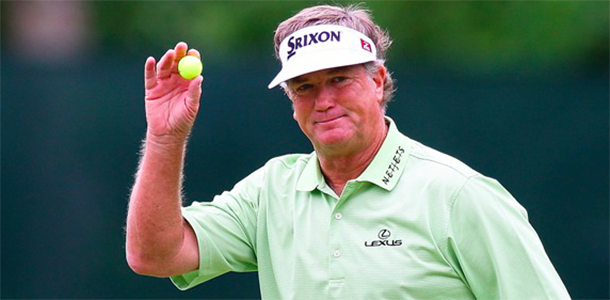
Another win, at the 2003 Greater Hartford Open at the ripe old age of 49, took his win-total on the PGA Tour to seven. He made an impressive 49 cuts at 57 majors, finishing in the top-10 six times and recording two third-place finishes at the PGA Championship.
As a senior, Jacobsen made an almost immediate impact, winning the 2004 U.S. Senior Open just three months after undergoing hip surgery. He won a second senior major at the 2005 Senior Players Championship.
Jacobsen wound down his playing career as he approached his 60s and now is a golf commentator on NBC. He has also co-designed a number of courses, including the excellent Rope Rider at Suncadia, with Jim Hardy, played guitar and was lead vocalist for “Jake Trout and the Flounders” which he formed in the 1980s with Mark Lye and Payne Stewart. Jacobsen also founded his own sports management and marketing company in 1988.
Jacobsen has enjoyed a stellar career on and off the golf course, including an annual and popular three-day charity event held in the Portland area until 2002, which became known as “Peter’s Party.”
But perhaps the incident for which he is best-known – for a certain generation at least – remains his remarkable rugby-style tackle of a streaker on the 72nd green of the 1985 Open Championship at Royal St. George’s. Only Peter Jacobsen would have considered such a move, which is why he remains one of the most popular golfers in the game.
Stan Leonard
British Columbia’s finest, Stan Leonard’s list of achievements in his native country where he played most of his golf while also serving as the head pro at Marine Drive GC in Vancouver is, frankly, absurd.
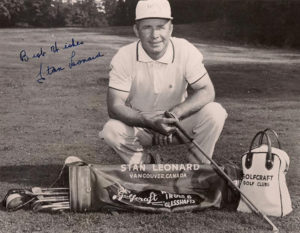
Leonard, just 5’6” tall and known as “Popeye” because of his massive forearms, won the first tournament he ever entered, the 1932 BC Amateur. He won that championship again in 1935, and turned professional in 1938. It didn’t take him long to become the finest player in the land.
In all, he would win eight Canadian PGA Championships, five BC Opens, nine Alberta Opens, and two Saskatchewan Opens. He was low-Canadian at the Canadian Open eight times, and was a member of the Canadian Team for the Canada Cup (later the World Cup of Golf) on nine occasions, winning the individual title in 1954 and ’59.
Leonard captured two Canadian Match Play titles, but played his best golf in winning three events on the PGA Tour between 1957 and 1960. At the Masters, he finished in the top-10 four times. In the 1963 Seattle Open, at age 48 he tied for second with the 20-year-old Raymond Floyd. After turning 50, Leonard won three Canadian Senior PGA Championships.
Leonard was inducted into Canada’s Sports Hall of Fame in 1964, the BC Sports Hall of Fame in 1966, the Canadian Golf Hall of Fame in 1972, and the Golf Hall of Fame of BC in 2001.
The PGA of British Columbia has named its annual Player of the Year Award after Stan Leonard.
Sam Snead wasn’t joking when he said he was glad Leonard hadn’t joined the PGA Tour until he was 40.
Ryan Moore
Dwayne Knight well remembers recruiting 2001 Washington State High School champion Ryan Moore for his UNLV Rebels team.
“I went to watch him several times, and knew he was something special pretty quickly,” he says. “But he never gave me any indication he wanted to play in Las Vegas, so I was extremely happy when he finally agreed to accept our scholarship offer.”
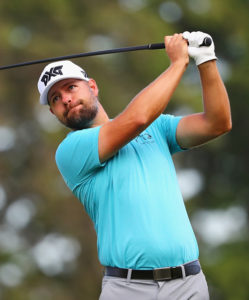
Moore was selected for the U.S. team in the 2003 Walker Cup at Ganton in England, then won the NCAA Division I individual title at the end of his junior year in 2004. It was the start of an incredible season of golf. In short order, Moore won the Sahalee Players Championship, the Western Amateur, the U.S. Amateur Public Links (which he had also won in 2002), and the U.S. Amateur at Winged Foot, beating Luke List in the final match.
“It was the most incredible few months I have ever seen,” says Knight. “He really was unbeatable that summer.”
Not surprisingly, Moore won the Nicklaus, Hogan, and Haskins awards in his senior year as the nation’s top collegiate golfer, and also finished low amateur at the 2005 Masters, completing the 72 holes at Augusta National in one-under 287 and tying for 13th.
Fourteen years on, Moore is an established PGA Tour star, having won five times. He played on the U.S. team in the 2016 Ryder Cup at Hazeltine, where he earned two points, winning his Saturday four-ball match alongside JB Holmes and beating Lee Westwood in the singles.
Anne Sander
Anne Sander’s bullet-point list of victories and achievements on the PNGA website (see: PNGA Hall of Fame) is perhaps the longest of all. She had the advantage of being born into a family that owned a golf course – Cedarcrest in Marysville, Wash. – though her parents didn’t actually play.
A child prodigy, Sander, born Anne Quast in 1937, lost in the final of the Washington State Women’s Public Links at the age of 14, but won her first State Girls’ Championship the following year, 1952 (the same year she was medalist at the U.S. Girl’s Junior, where she would eventually lose in the semifinals). She repeated the victory two years later and then again in 1955, in her final year of eligibility.
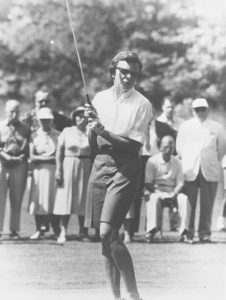
Her rivalry with fellow Washingtonian JoAnne Gunderson Carner (they grew up 30 miles apart) developed in the early 1950s. Quast held the upper hand more often than not, winning her first Washington State Women’s Amateur in 1955 and defending the title in ’56 by which time she had begun her studies at Stanford University.
Sander won her first of three U.S. Women’s Amateur titles in 1958 (she also had three runner-up finishes). She and Carner, undeniably the two leading women amateurs at the time, met three times in match play in the U.S. Women’s Amateur, Sander winning the first two bouts, Carner the third.
A committed amateur her entire career, Sander played infrequently and didn’t play at all between 1970 and ’73.
In 1974, she moved with her husband Steve to England where they would live for five years during which time Sander lost her game completely. It was only when she returned to the U.S. that she regained it, pounding balls on the range at Seattle’s Broadmoor GC.
In 1980, with her swing fully restored, Sander returned to England and won the British Women’s Amateur at Woodhall Spa.
With so many significant amateur wins, it’s no surprise Sander was chosen to represent her country on a number of occasions. She was chosen for the U.S. Curtis Cup team an incredible seven times over five decades, and was a member of the U.S. team at the World Amateur Team Championship three times.
Sander excelled at the senior level too, claiming four U.S. Senior Women’s Amateur titles, cementing her place in the Washington State Sports Hall of Fame and Pacific Northwest Golf Association Hall of Fame.
Marvin ‘Bud’ Ward
Though he enjoyed some success as a professional golfer after leaving the amateur ranks in 1951, it was as an amateur that Marvin “Bud” Ward shone.
Born in Elma, Wash. in 1913, Ward was a strong, solidly-built man with deft hands. As a young man, he worked in the state tax office in Olympia, but moved to Spokane in 1939 to work for the city’s Athletic Round Table which promoted sporting activity.
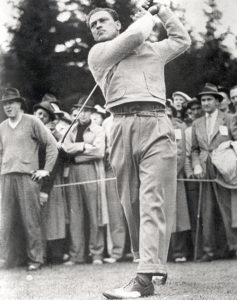
There he joined Spokane Country Club and shortly after, won the first of his five Northwest Open titles, all as an amateur. Ward also made a splash on the national stage in 1939, finishing fourth at the U.S. Open at Philadelphia CC, one shot out of the three-man playoff. And he won the first of his two U.S. Amateurs that year as well, beating Ray Billows 7&5 in the final at North Shore CC in Chicago.
Obviously, 1939 was a stellar year for Ward, but he eclipsed it two years later when he won the PNGA Men’s Amateur, Western Amateur and U.S. Amateur all within two months of each other. At the U.S. Amateur in Omaha, he defeated Pat Abbott 4&3 in a controversial final match during which he encountered more than his share of heckling from the pro-Abbott gallery.
As well as the two U.S. Amateur titles and five Northwest Opens, Ward won the prestigious Western Amateur three times and played on two Walker Cup teams – in 1938 at St. Andrews where he won his Saturday singles 12&11 (36-hole match), and 1947, also played at St. Andrews.
Ward turned professional in 1951 and served as the head professional at Peninsula G&CC in San Mateo, Calif. He won seven events as a pro, including twice winning both the Northern California Open and Northern California PGA Championship. He was inducted into the PNGA Hall of Fame in 1979, and the Pacific Northwest Section PGA Hall of Fame in 1981.
Who’d we miss?
Know someone who belongs on this list? Let the debate begin. Send your idea to [email protected].

